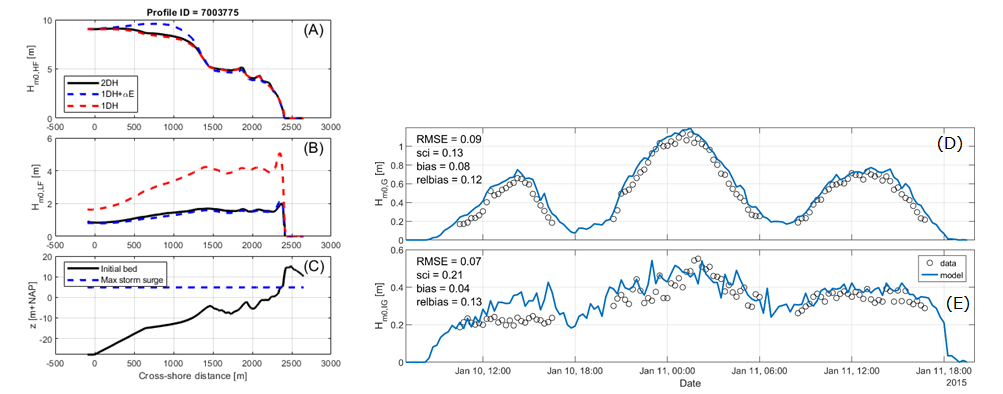R. McCall1*, R. van Santen2, R. Wilmink3, A. de Bakker1, H. Steetzel2, S. Pluis3, M. de Ridder1, L. Coumou2, N. van Kuik3
1 Deltares
2 Arcadis
3 Rijkswaterstaat
*corresponding author:
Introduction
Dunes and beaches protect large stretches of the Dutch coast against flooding. As prescribed by the Dutch Water Law, the Dutch dune coast is periodically assessed to ensure an acceptable level of flood risk. This safety assessment methodology is currently being updated within the framework of the program BOI (Assessment and Design of Flood Defences) to utilize the process-based storm impact model XBeach, instead of the empirical dune erosion model DUROS+. As part of this work, improvements to XBeach model formulations have been made, and extensive validation has been carried out using laboratory and field data.
Model improvements and field validation
One of the advantages of the XBeach model over DUROS+ is its ability to simulate both incident-band and infragravity-band hydrodynamics. As a key driver of dune erosion during storms, it is imperative that the XBeach model represents infragravity waves well in settings relevant to the Dutch safety assessment.
Alongside the development of modelling guidelines and default model parameters, the 1D XBeach formulations were also improved to better represent infragravity waves in directionally-spread seas. While computationally cheaper than their 2DH equivalents, 1D models suffer from the assumption of alongshore uniformity in hydro- and morphodynamics. This assumption presents well-known challenges for application in complex coastal areas. However, an additional, lesser-known challenge presents itself in XBeach (in common with wave flume experiments), in that the 1D assumption of alongshore uniformity in the (instantaneous) hydrodynamics leads to strong transfer of energy from the incident wave band to the infragravity wave band, and hence a substantial overestimation of nearshore infragravity wave energy relative to field conditions. This subsequently leads to overestimation of dune erosion and overwash. To allow for the application of 1D XBeach models in the safety assessment, we have validated a heuristic approach that allows us the model to mimic the effect of wave directional spread on infragravity wave energy and provide better estimates of dune erosion. This approach was subsequently validated using field observations of nearshore hydrodynamics.
We look forward to presenting these developments and their validation at the NCK conference.

Figure 1: Comparison of 2DH (black), uncorrected 1D (red) and corrected 1D (blue) simulated wind wave (A) and infragravity wave (B) transformation on coastal profile (C). Comparison of 1D corrected (blue) and observed (circles) wind waves (D) and infragravity waves (E) in field validation case.
I. Surname1*, F.N. Another-Surname2 , Y. Next-Surname2
1 University Name, Country; 2 Organization Name, Country
* Corresponding author: mail.name@organization.org


